A simplified technique for grafting watermelon onto resistant cucurbit rootstocks for control of Fusarium wilt of watermelon in Nghe An Province, Vietnam
V. T. Dau A , N. V. Dang B , D. H. Nguyen A , L. T. Pham A , T. T. M. Le A , H. T. Phan C and L. W. Burgess D EA Nghe An Plant Protection Sub-Department, 19 Tran Phu St., Vinh, Nghe An, Vietnam.
B Syngenta, 16 3A St., Bien Hoa 2 Industrial Area, Dong Nai, Vietnam.
C National Institute of Medicinal Materials, 3B Quang Trung St, Hanoi, Vietnam.
D Faculty of Agriculture, Food and Natural Resources, The University of Sydney, Sydney, 2006, New South Wales, Australia.
E Corresponding author. Email: burgess.international@gmail.com
Australasian Plant Disease Notes 4(1) 114-116 https://doi.org/10.1071/DN09047
Submitted: 18 October 2009 Accepted: 3 November 2009 Published: 30 November 2009
Abstract
Resistant cucurbit rootstocks provided an effective control measure for Fusarium wilt of watermelon caused by Fusarium oxysporum f. sp. niveum in Nghe An province, Vietnam. The hybrid cultivar, Bulrojangsaeng (Lagenaria siceraria) was the most suitable rootstock on all criteria but the seed is expensive. Therefore, the local Bau trang cultivar (L. siceraria) was adopted by farmers as the preferred rootstock on the basis of the low-cost seed. The grafting process is described and illustrated.
Fusarium wilt of watermelon, caused by Fusarium oxysporum f. sp. niveum, was responsible for serious losses in watermelon crops in Nghia Dan District, Nghe An Province, Vietnam over the past 2 years, and is threatening the viability of the industry (Dau et al. 2009). Some fields are no longer used for watermelon production. In spring 2009 the area cropped to watermelon in Nghia Dan was 600 ha. The average yield of healthy crops was 25 tonnes/ha and the average price to the farmer was ~4100 VND (~US$0.37)/kg. Consequently it is a valuable cash crop for farmers in Nghia Dan. The incidence of wilted plants in all crops was assessed visually. The incidence was 10–20% in crops covering 80 ha, and 30–40% in crops covering 5 ha. The remaining crops, covering 515 ha, were either free of wilt or had scattered diseased plants. As access to irrigation water is limited there is little opportunity for farmers to avoid the disease by shifting to new ground. The disease has been spreading rapidly by inoculum transfer in soil on contaminated equipment and footwear, and particularly with transplants (Dau et al. 2009). The use of watermelon seedlings grafted onto resistant cucurbit rootstocks was identified as the only feasible control measure with the potential to prevent infection of susceptible watermelon in soils with high levels of inoculum of the pathogen. Watermelons have been grafted onto gourd rootstocks in Japan and Korea since the 1920s (Lee 1994). Indeed the use of watermelon transplants grafted onto resistant cucurbit rootstocks for control of Fusarium wilt is now common practice in many countries (Lee and Oda 2003; Boughalleb et al. 2007; Besri 2008). This strategy for controlling Fusarium wilt has become more popular as it is an effective replacement for methyl bromide fumigation of soil (Besri 2008), a control measure that is being phased out worldwide as a consequence of environmental concerns. The widespread adoption of the use of tomato transplants grafted onto resistant rootstocks for the control of bacterial wilt in Vietnam (Ngo and Ngo 2005) has provided a valuable demonstration to local plant protection extension staff and farmers of the role of resistant rootstocks in the control of diseases caused by soil-borne pathogens. A range of grafting techniques was evaluated in ad hoc trials in 2008 but they were considered too complicated for the situation in Nghe An. For example, the use of clips, tape or sleeves is costly and slows the grafting process. Consequently we adopted a simplified hole insertion grafting technique. This is a fast and reliable technique. It has the advantage that it does not require clips, tape or sleeves. The technique is described below. We also report on the evaluation of a range of potential resistant rootstocks in respect of graft compatibility, and the assessment of two rootstock-scion combinations under commercial conditions.
The three basic tools used by our cooperating farmers are a home-made mini-scalpel, a stylus and a razor blade (Fig. 1). The mini-scalpel is made from a small section of a razor blade that is glued to a bamboo chopstick or similar handle. The home-made stylus is made from a hard plastic toothbrush handle sharpened at one end. A collar of cotton thread is glued ~10 mm from the point to act as a depth control guide.
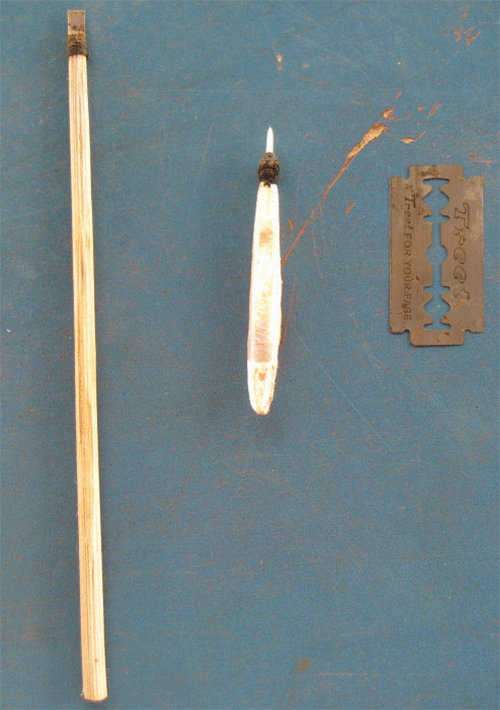
|
The rootstock seedlings were grown in pathogen-free forest soil in small plastic bags, one seed per bag. Five to eight days later, depending on the temperature, watermelon seeds are sown densely in clean river sand in a large plastic dish or similar container.
The grafting process involves excising the stem of the rootstock seedling immediately above the cotyledons, at the first true leaf stage using the mini-scalpel (Fig. 2). A narrow cone shaped hole, ~6–8 mm deep, is then made in the stem of the rootstock with the stylet (Fig. 3). The upper part of the stem, 10–15 mm long (scion) of a watermelon seedling at the cotyledon stage, is then removed with a razor blade, making an oblique transverse cut (Fig. 4). The scion is then inserted into the hole in the rootstock stem (Fig. 5). The grafting process takes ~10–15 s. The success rate is ~80% or greater depending on experience. The grafted seedlings are first kept under cool shady conditions for several days (Fig. 6), and then hardened outdoors in an area sheltered from the wind and excessive sun, or in a screenhouse. They are transplanted to the field after three to four leaves have developed. A successful graft in a mature plant is shown in Fig. 7.
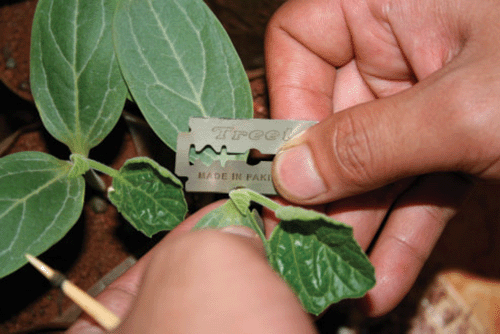
|
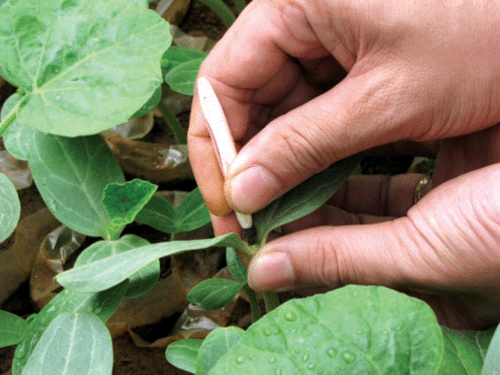
|
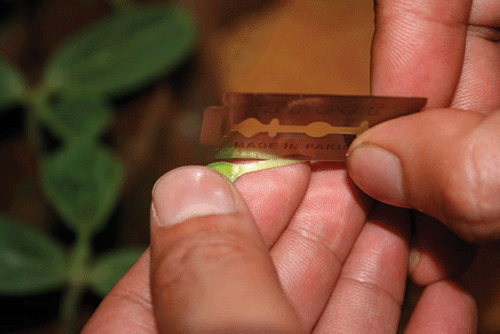
|
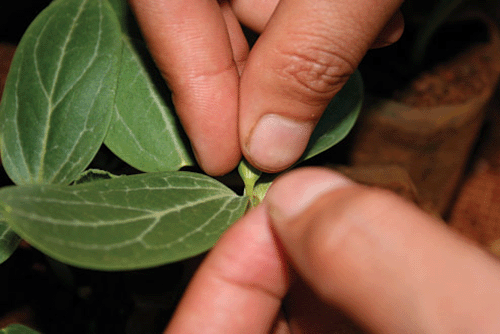
|
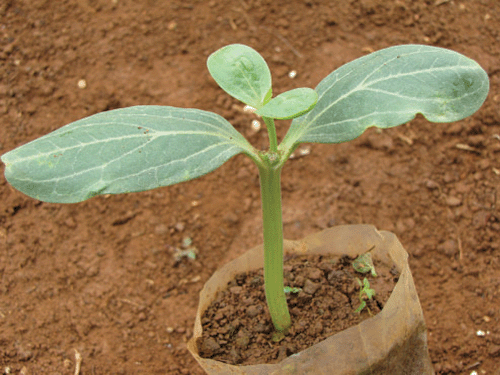
|
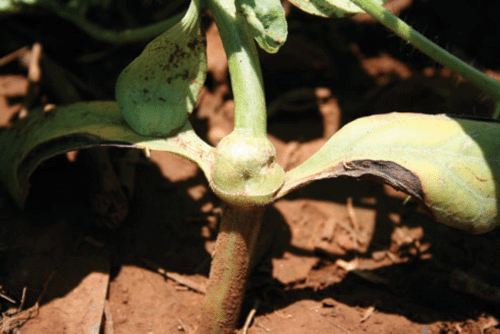
|
We evaluated the local cultivar Bau trang (L. siceraria (bottle gourd)) together with five hybrid cucurbits for use as resistant rootstocks. The hybrids, provided by Syngenta, Thailand, were Kazako, Carnivar and Bulrojangsaeng (S. siceraria), and Emphasis and Argentaria (provenance not known). The Bulrojangsaeng hybrid was the most suitable rootstock but the farmers consider it too expensive. Consequently the Bau trang cultivar was used as a resistant rootstock in an initial 0.1 ha field trial in soil with a history of severe Fusarium wilt, in spring 2009. Two watermelon cultivars from Syngenta, Thuy Loi and Phu Dong, were used as scions. The grafted plants were not affected by Fusarium wilt and produced marketable fruit. Both rootstock scion combinations were satisfactory.
Staff from Nghe An Plant Protection Sub-Department and Syngenta held farmer field-schools on Fusarium wilt and the grafting technique in March, 2009. It is expected that grafted transplants will be used widely in the spring 2010 crops on fields with a history of wilt. Ideally the transplants will also be used in fields with no history of wilt to prevent a build-up of inoculum in soil.
The use of watermelon grafted onto resistant rootstocks provides a valuable management practice for the prevention of Fusarium wilt in soils with high inoculum levels. The cost of seed in relation to yield, fruit quality and market acceptance in Hanoi will determine the preferred combinations of scions and rootstocks for use in Nghe An.
The use of resistant rootstocks has potential for use in the control of other diseases caused by soil-borne pathogens in a range of annual and perennial crops in Vietnam. The use of cucurbit and tomato transplants grafted onto resistant rootstocks has been widely adopted worldwide. The use of snake bean transplants grafted onto cowpeas (cv. Iron), (Conde et al. 2002) illustrates the potential for grafting in other crop plant families. Further research is needed in Nghe An on the influence of rootstock scion combinations on yield and quality of watermelon and the incidence and severity of other diseases.
Acknowledgements
Financial support from the Australian Centre for International Agricultural Research (ACIAR CP/2002/115) is gratefully acknowledged.
Boughalleb N,
Tarchoun N,
El Mbarki A, El Mahjoub M
(2007) Resistance Evaluation of Nine Cucurbit Rootstocks and Grafted Watermelon (Citrullus lanatus L.) Varieties Against Fusarium Wilt and Fusarium Crown and Root Rot. Journal of Plant Sciences 2, 102–107.
| Crossref | GoogleScholarGoogle Scholar |

Dau VT,
Burgess LW,
Pham LT,
Phan HT,
Nguyen HD,
Le TV, Nguyen DH
(2009) First report of Fusarium wilt in watermelon in Vietnam. Australasian Plant Disease Notes 4, 1–3.
| Crossref | GoogleScholarGoogle Scholar |

Lee JM
(1994) Cultivation of grafted vegetables. 1. Current status, grafting methods, and benefits. HortScience 29, 235–239.

Lee JM, Oda M
(2003) Grafting of herbaceous vegetable and ornamental crops. Horticultural Reviews 28, 61–125.

Ngo VQ, Ngo CX
(2005) Results of research and application of grafting tomato to control bacterial wilt in Lam Dong and Ho Chi Minh City. Journal of Agricultural and Rural Development Science December, 19–21.



